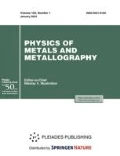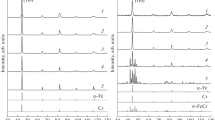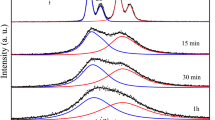Abstract
Nanocrystalline Fe–Cr alloys synthesized from pure components in a planetary ball mill with a chromium content of 20–48 at % were annealed for 4 h at temperatures of Tan = 400–700°C. Short-range order (SRO) evolution and phase separation dependent on Tan were studied using Mössbauer spectroscopy and X-ray diffraction. The precipitation of the σ-FeCr phase was observed only in the samples with 48 at % of Cr at Tan = 600 and 700°C. For all the samples, the grain growth began most intensively from 400°C, and the higher the Cr content in an alloy, the smaller the final size of grains after Tan = 700°C. The analysis of behavior of the mean hyperfine field on Fe nuclei and distribution of the hyperfine field width depending on Tan, as well as fitting of Mössbauer spectra with spectral components corresponding to the α (Cr depleted) and α' (Cr rich) phases, demonstrated that the mechanically alloyed Fe-Cr samples were characterized by weak short-range separation passing at Tan = 400°C to a nearly statistically uniform distribution of atoms. Heterogeneous short-range order with the α and α' regions was formed in the alloys with 30 at % of Cr and more after annealing at 500–700°C. An analysis with the material balance equation led to our conclusion about the existence of the grain boundary segregations of Cr atoms.






Similar content being viewed by others
REFERENCES
R. L. Klueh and D. R. Harries, High-Chromium Ferritic and Martensitic Steels for Nuclear Applications (ASTM stock Number: MONO3, USA, 2001).
W. Xiong, M. Selleby, Q. Chen, J. Odqvist, and Y. Du, “Phase equilibria and thermodynamic properties in the Fe–Cr system,” Crit. Rev. Solid State Mater. Sci. 35, 125–152 (2010).
T. Koyano, U. Mizutani, and H. Okamoto, “Evaluation of the controversial σ → (Cr) + (α–Fe) eutectoid temperature in the Fe–Cr system by heat treatment of mechanically alloyed powder,” J. Mater. Sci. Lett. 14, 1237–1240 (1995).
M. Murugesan and H. Kuwano, “Magnetic properties of nano-crystalline Fe–Cr alloys prepared by mechanical alloying,” IEEE Trans. Magn. 35, 3499–3501 (1999).
A. Fnidiki, C. Lemoine, and J. Teilet, “Properties of mechanically alloyed Fe100 – xCrx powder mixtures: Mössbauer study,” Phys. B 357, 319–325 (2005).
B. Pandey, M. A. Rao, H. C. Verma, and S. Bhargava, “Mössbauer spectroscopic studies of Fe–20 wt % Cr ball milled alloy,” Hyperfine Interact. 169, 1259–1266 (2006).
E. P. Yelsukov, D. A. Kolodkin, A. L. Ul’yanov, and V. E. Porsev, “The initial stage of mechanical alloying in Cr–Fe binary systems,” Colloid J. 77, 143–153 (2015).
E. P. Elsukov, A. L. Ul’yanov, V. E. Porsev, D. A. Kolodkin, A. V. Zagainov, and O. M. Nemtsova, “Peculiarities of mechanical alloying of high-concentration Fe–Cr alloys,” Phys. Met. Metallogr. 119, 153–160 (2018).
E. P. Yelsukov, A. L. Ul’yanov, D. A. Kolodkin, and V. E. Porsev, “Kinetics of mechanochemical dissolution of chromium in iron,” Colloid J. 78, 443–447 (2016).
M. Ames, J. Markmann, R. Karos, A. Michels, A. Tschöpe, and R. Birringer, “Unraveling the nature of room temperature grain growth in nanocrystalline materials,” Acta Mater. 56, 4255–4266 (2008).
R. Kirchheim, “Grain coarsening inhibited by solute segregation,” Acta Mater. 50, 413–419 (2002).
I. Mirebeau and G. Parette, “Neutron study of the shot range order inversion in Fe1 – xCrx,“ Phys. Rev. B 82, 104203–1–5 (2010).
A. Froideval, R. Iglesias, R. M. Samaras, S. Schhuppler, P. Nagel, D. Grolimund, M. Victoria, and W. Hoffelner, “Magnetic and structural properties of FeCr alloys,” Phys. Rev. Lett. 99, 237201–1–4 (2007).
N. P. Filippova, V. A. Shabashov, and A. L. Nikolaev, “Mössbauer study of irradiation-accelerated short-range ordering in binary Fe–Cr alloys,” Phys. Met. Metallogr. 90, 145–152 (2000).
A. Jacob, E. Povoden-Karadeniz, and E. Kozeschnik, “Revised thermodynamic description of the Fe–Cr system based on an improved sublattice model of the σ phase,” CALPHAD: Comput. Coupling Phase Diagrams Thermochem. 60, 16–28 (2018).
R. Idczak, R. Konieczny, and J. Chojcan, “Atomic short-range order in Fe1 – xCrx alloys studied by 57Fe Mössbauer spectroscopy,” J. Phys Chem. Solids 73, 1095–1098 (2012).
S. M. Dubiel and J. Zukrowski, “Phase-decomposition-related short-rang odering in a Fe–Cr alloy,” Acta Mater. 61, 6207–6212 (2013).
S. M. Dubiel and J. Cieslak, “Short-range order in iron-rich Fe–Cr alloys as revealed by Mössbauer spectroscopy,” Phys. Rev. B 83, 180202-1–180202-4 (2011).
G. A. Dorofeev, A. N. Streletskii, I. V. Povstugar, and A. V. Protasov, and E.P. Elsukov, “Determination of nanoparticle sizes by X-ray diffraction,” Colloid J. 74, 675–685 (2012).
V. V. Ovchinnikov, Mössbauer Analysis of the Atomic and Magnetic Structure of Alloys (Cambridge Int. Science, 2006).
E. V. Voronina, N. V. Ershov, A. L. Ageev, and Yu. A. Babanov, “Regular algorithm for the solution of the inverse problem in Mössbauer spectroscopy,” Phys. Status Solidi B 160, 625–634 (1990).
G. Y. Vélez and G. A. Pérez Alcázar, “Influence of atomic ordering on sigma phase precipitation of the Fe50Cr50 alloy,” J. Alloys Compd. 644, 1009–1012 (2015).
G. K. Wertheim, V. Jaccarino, J. H. Wernick, and D. N. E. Buchanan, “Range of the exchange interaction in iron alloys,” Phys. Rev. Lett. 12, 24–27 (1964).
H. Kuwano, Y. Ishikawa, T. Yoshimura, and Y. Hamaguchi, “Characterization of the spinodal decomposition of Fe−Cr alloys by Mössbauer spectroscopy,” Hyperfine Interact. 69, 501–504 (1992).
H. Kuwano, Y. Nakamura, K. Ito, and T. Yamada, “Spinodal decomposition of Fe–Cr–Ni alloys studied by Mössbauer spectroscopy,” Nuovo Cimento D 18, 259–262 (1996).
J. Cieslak and S. M. Dubiel, “Nucleation and growth versus spinodal decomposition in Fe–Cr alloys: Mössbauer-effect modelling,” J. Alloys Compd. 269, 208–218 (1998).
L. Trieb and G. Veith, “Kinetic study of short range order in α-CuAl alloys,” Acta Metall. 26, 185–196 (1978).
L. R. Owen, H. Y. Playford, H. J. Stone, and M. G. Tucker, “A new approach to the analysis of short-range order in alloys using total scattering,” Acta Mater. 115, 155–166 (2016).
L. M. Cowley, “An Approximate theory of order in alloys,” Phys. Rev. 77, 669–675 (1950).
O. Brümmer, G. Dräger, and I. Mistol, “Determination of the short-range order in Fe–12.3 at %–Al alloys using the Mössbauer effect,” Ann. Phys. 28, 135–140 (1972).
Funding
This work was performed within the state task of the Ministry of Education and Science of the Russian Federation (project no. 0427-2019-0011) using the equipment of the Shared Facilities Center of the Udmurt Federal Research Center of the Ural Branch of the Russian Academy of Sciencesс under the support of the Ministry of Education and Science of the Russian Federation within the Federal Target Program (unique project identifier RFMEFI62119X0035).
Author information
Authors and Affiliations
Corresponding author
Additional information
Translated by E. Glushachenkova
Rights and permissions
About this article
Cite this article
Porsev, V.E., Ul’yanov, A.L. & Dorofeev, G.A. Short-Range Order Evolution in Nanocrystalline Mechanically Activated Fe–Cr Alloys in the Process of Annealing. Phys. Metals Metallogr. 121, 783–790 (2020). https://doi.org/10.1134/S0031918X20080086
Received:
Revised:
Accepted:
Published:
Issue Date:
DOI: https://doi.org/10.1134/S0031918X20080086




